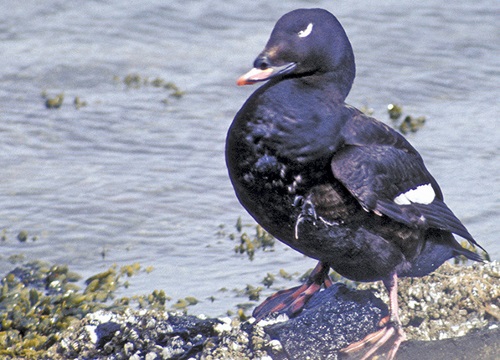 We arrived at the refuge at daybreak and had already spent an hour watching huge flocks of waterfowl in the coves at Eastern Neck National Wildlife Refuge in Kent County, MD. Our attention shifted to the open waters leading away from the Chester River into the main body of the Chesapeake Bay. We weren’t disappointed.
We arrived at the refuge at daybreak and had already spent an hour watching huge flocks of waterfowl in the coves at Eastern Neck National Wildlife Refuge in Kent County, MD. Our attention shifted to the open waters leading away from the Chester River into the main body of the Chesapeake Bay. We weren’t disappointed.
Fifty yards offshore, a small raft of sea ducks was loafing on the still waters. I focused the spotting scope on the center of the group and pulled a large black duck into focus.
A white stripe on its flank and another around its eye were the only marks on this bulky black duck. The bill’s end was red, adding the only other splash of color. These were white-winged scoters (Melanitta fusca).
As I swiveled the magnification knob, the oddly shaped bill grew in the eyepiece. The calm waters made it easy to focus on the big bulge at the base of the bill. As black as the rest of the bird, the hump is a common feature in sea ducks, giving them a fat nose look.
Around the eye with its eerie white iris, a white inverted comma of feathers reached back and up, looking like the famous Nike swoosh symbol.
At the other end of the bird, a white slash rose from the waterline toward the tail. These feathers are part of the white speculum, a panel of secondary feathers on the wing that is most visible in flight and gives the bird its name.
I was looking at a male. Females are similar but lack the comma. Instead, they have two white facial patches, one at the base of the bill and another on the cheek. The females are dark brown, but look black except under ideal lighting conditions. They also have brown eyes, and their bills are grayish black with a hint of red.
Scoters are big. They are nearly 2 feet long and weigh about 3 pounds.
White-winged scoters arrive in the Chesapeake starting in late October and their numbers peak by Thanksgiving.
They come from the northwest interior of North America — western Canada and parts of Alaska.
These scoters breed in the Holarctic region — the bio-geographic region that extends around the top of the world. In Europe, Melanitta fusca is known as the “velvet scoter,” for its smooth, not glossy, black body.
In North America, white-winged scoters breed on large lakes and ponds. The female builds a rudimentary nest well away from the water, invariably on the ground under dense vegetation.
She typically lays nine to 10 eggs and incubates them for a month. (The males leave as soon as the eggs are laid.) The eggs will hatch all at once. As soon as the chicks are dry, mom leads them to the nearby lake where they immediately start swimming and feeding themselves.
White-winged scoters often share breeding territory with gulls — a deadly location. Gulls prey on the ducklings in large numbers. Getting into the water, where the baby scoters can dive below the surface for cover, is imperative. Even there, the young ducks are not entirely safe. Large fish like northern pike also prey on the ducklings.
Not surprisingly, survival rates among the young are exceedingly low. Many nests are lost entirely to attacking mammals like mink or hungry birds like gulls and crows. White-winged scoters only produce a single brood annually, even if the first is lost. In some breeding areas, 90 percent of the birds are lost in the first year.
If they survive that perilous first few months, these are hardy birds. Only common eiders are able to better withstand the cold.
When the white-winged scoters leave their natal lake in the fall, they disperse along both coasts. Along the Pacific, they spend the winter from British Columbia to Baja, Mexico. Others fly across the continent and winter on the Atlantic Coast from the Maritime Provinces to Florida and even the Gulf Coast. A small number overwinter on the Great Lakes.
About 30 percent of all Atlantic Coast birds come to the Chesapeake Bay. They come for the clams.
The white-winged scoter can dive several meters to reach shellfish beds. There, they tear a clam or mussel away from the colony using their powerful bills. The scoters swallow their food whole, relying on their gizzards to grind and dissolve the shells so their stomachs can then digest the meat within.
Viewing the sea ducks lolling on the Bay left me in a reflective mood.
Wendell Berry writes of “the peace of wild things who do not tax their lives with forethought of grief.”
I think the same must be true of recollection. These wild things do not suffer the memories of violence endured years before. They are simply resting on the waters, and for that I am profoundly grateful.
By Bay journals Mike Burke, an amateur naturalist who lives in Cheverly, MD.

